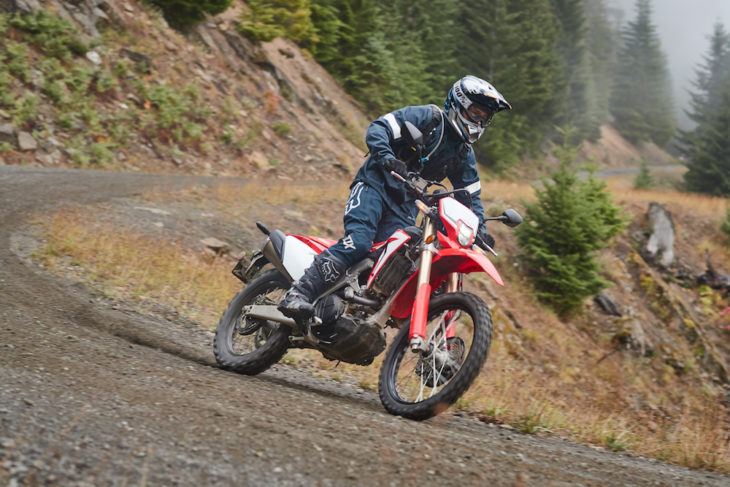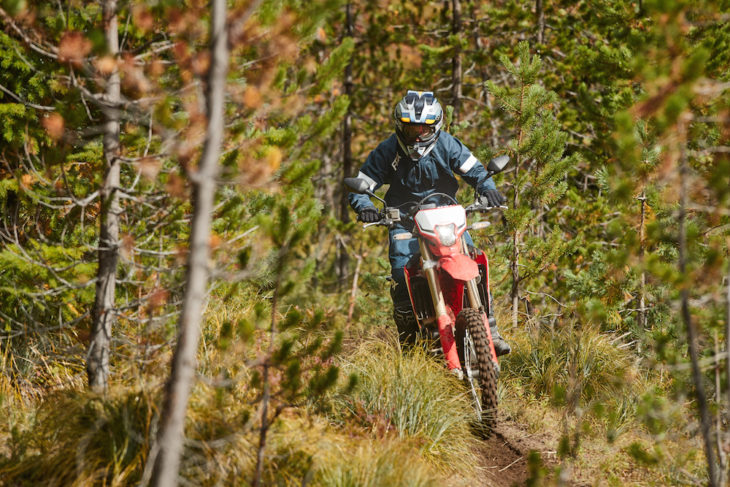Cycle News Staff | September 19, 2018
Eleven-time Baja 1000 winner Johnny Campbell talks the way any good teacher would. Clearly and with enough confidence that you too feel—confident. Which in this moment, I’m not. “The section ahead is really tricky,” he says. “Keep your momentum up, use what the bike has to offer, and roll right over the boulders; it’ll handle it.” Like a good student, who may or may not be in a predicament and really needs the advice, I listen.
2019 Honda CRF450L Dual Sport First Impression
 Getting our first taste of the 2019 Honda CRF450L in Washington. Photos: Drew Ruiz
Getting our first taste of the 2019 Honda CRF450L in Washington. Photos: Drew Ruiz
As Campbell vowed, the motorcycle obliges, carrying me back to safe grounds. Not because of talent, but rather its off-road prowess. This is how the rest of my day would go aboard the all-new 2019 Honda CRF450L.
In creating the CRF450L, Honda’s idea was simple: Deliver a full-fledged off-road motorcycle capable of handling the most technical trails, but with best-in-class street performance to handle trail-to-trail asphalt stints. The boys in red weren’t after the best of one world, they want the best of all worlds. This meant that they would have to turn to their legendary CRF off-road lineup for a starting platform, then tailor it to the many challenges of dual sport riding.
 The CRF450L retains the lively chassis feel of the R model basis, making quick work of any corner, but remaining planted and inspiring confidence.
The CRF450L retains the lively chassis feel of the R model basis, making quick work of any corner, but remaining planted and inspiring confidence.
Where’s the starting point? The basis for the L model comes in form of the CRF450R—the best-selling motocrosser in the industry—meaning they share the same 449cc Unicam four-stroke engine that has become legendary in the motocross world. To make power more tractable on technical trails, Honda increased crankshaft inertia by 12 percent and gave the L model a heavier clutch basket, as well as dedicated ECU settings. The CRF450L also receives dedicated valve timing, large-capacity radiators, and a single-muffler exhaust system aimed at lessening sound and meeting emissions standards. Also highlighting the L model’s powerplant is a wide-ratio six-speed transmission. The market asked, Honda listened.
The chassis package is much the same as the R model, but the main frame grows in width by 15 millimeters to house the six-speed transmission. Rake numbers were also increased, with Honda pushing the L model up to 28 degrees for better straight-line stability than the R. It also shares the 49mm Showa coil-spring front fork and rear shock with its motocrossing cousin, except valving has been softened to handle rock gardens and roots rather than rhythm sections. The subframe has also been extended and optimized for carrying adventure kits. Our backs thank you in advance, Honda.
 Much thanks to Honda’s effort at reducing road noise and vibration, the CRF450L’s on-road performance is second to none.
Much thanks to Honda’s effort at reducing road noise and vibration, the CRF450L’s on-road performance is second to none.
Converting the CRF to a dual sport contender meant emphasizing on ride comfort, so you can ride all day without rattling yourself silly. Honda employed a set of rubber-cushioned sprockets to help with this, with an added duty of reducing chainslap. Likewise, the engine gets protection from plastic engine covers and the swingarm gets injected with urethane to reduce road noise. To achieve road legality, Honda fitted the CRF450L with a LED lighting system and rear-view mirrors.
Honda arranged for us to test the CRF450L over the course of a 100-mile route in the Pacific Northwest. A perfect location because the trail system here is unfathomly extensive and pictures taken here make us feel like super heroes. And because if Honda really built the 450L to outperform its competitors both on and off road, this would be the spot to showcase it. It has lots of both. This is dual sport heaven.
 A tractable power delivery when a long way in our liking for the CRF450L, but so did its braking components. The thicker brake rotor and large capacity reservoir offered plenty of fade resistant stopping power.
A tractable power delivery when a long way in our liking for the CRF450L, but so did its braking components. The thicker brake rotor and large capacity reservoir offered plenty of fade resistant stopping power.
Somewhere between our starting point and the first mile of single track, the Honda became a best friend. One that has your back, even helping laugh off the difficulties life has to offer. Or in my case, the technicality of the section ahead.
The CRF450L’s linear power delivery has a lot to do with this. Despite the engine being heavily derived from the throaty CRF450R, the dual sport model offers a gentle initial throttle response, making it unintimidating and user friendly on difficult terrain. The bottom-end power has enough grunt to pop the front wheel over obstacles, while still offering an uneventful drive over slippery soil. The power delivery to redline is equally as smooth. It doesn’t have the same quick-revving nature of its R model cousin, but nor does it need it. The 450L is plenty capable of hustling you from one point to the next, but in a way that’s confidence inspiring enough for you to give it a little more throttle on the straights, pretending you’re as talented as Johnny Campbell. Yeah, right.
 A little less Baja, a little more woods, but the CRF450L makes you feel as talented as Johnny Campbell.
A little less Baja, a little more woods, but the CRF450L makes you feel as talented as Johnny Campbell.
Tipping the scales at 289 pounds fully fueled, you would think that the CRF450L would take a lot of muscling around, but it carries its weight shockingly well. Fatigue was almost absent for this reason. Whether it be open fire road sweepers or technical switchbacks, the CRF impresses with its ability to quickly track through either without thought. It’s always nimble on its feet, which goes a long way when speeding through unknown single track. Come around a corner to a nasty root directly in your path, just weight the pegs and go right around it. The CRF450L is lively, but planted and confidence inspiring when it needs to be, helping limit fatigue on the body.
There’s truth in saying that Honda’s focus on reducing vibration and sound on the CRF450L goes a long way in reducing exertion, too. The rubber-cushioned sprockets put an end to all chainslap, even when lugging the engine out of a sweeping corner. And then there’s the engine covers, urethane injected swingarm and L model-specific muffler; all of which contribute to a very quiet ride, while reducing vibration to a minimum. Had I only heard the Honda staff explain these pieces without riding the bike for myself, I’d have told you it’s a hoax. But I’ll admit it, this stuff really does work. And it works well.
 The L model uses the same 449cc Unicam engine as the R model, but gets tuned to deliver more tractable that’s needed from a dual sport bike.
The L model uses the same 449cc Unicam engine as the R model, but gets tuned to deliver more tractable that’s needed from a dual sport bike.
So well, actually, that it plays a major contribution in the CRF450L’s second-to-none road performance of similar-bore dual sports. For many competitors, highway stints are dreadful, often chattering your fillings out of your teeth and hands off the bars. Approximately 70 miles per hour is the sweet spot for the Honda. Cruising in sixth gear here still offers plenty of plenty of power to overtake traffic, but also glides along the asphalt with no complaints.
A couple of small details on the CRF450L grabbed our attention for good reason, as well. First was the fuel consumption reading displayed on the dash, which measures how much fuel of the 2.0-gallon fuel tank has been burned by flow-rate sensors in the fuel pump. It sounds mundane, but this small feature is especially useful in determining your fuel range, even more so in decision between riding back to camp or venturing on. The CRF450L also receives the same size brakes as the R model, but the front rotor grows in thickness and comes equipped with a higher capacity reservoir. This proved beneficial in long downhill sections, with plenty of stopping power and resistance to brake fade.
 Honda’s use of rubber-cushioned sprockets eliminated chainslap and road noise, helping lessen fatigue throughout the ride.
Honda’s use of rubber-cushioned sprockets eliminated chainslap and road noise, helping lessen fatigue throughout the ride.
In the CRF450L, Honda seems to have accomplished what it set out to do, and then some. The new dual sporter is complete as a package and difficult to find faults in, but that level of refinement comes at a cost. With an MSRP of $10,399, the buy-in price is by no means cheap, yet still considerably less than some of its European competitors. Throw in the full one-year warranty that comes standard with purchase and the CRF450L starts to look like a bargain—one that will loft itself over boulders, just as Johnny Campbell promised.
Don’t worry, we’re just getting started when it comes to the new CRF450L. We have plans to ride this bike a lot more in the near future so we can do a thorough test on this exciting new dual sporter.
Michael Gilbert
 We will have a full-on test of the new Honda CRF450L in a future issue of Cycle News magazine.
We will have a full-on test of the new Honda CRF450L in a future issue of Cycle News magazine.